

Want A Great Culture? Make Your Values Actionable – Part 1 - Center for Agile Leadership® High-Performing Teams Need Psychological Safety. Here’s How to Create It. Executive Summary The highest-performing teams have one thing in common: psychological safety — the belief that you won’t be punished when you make a mistake.
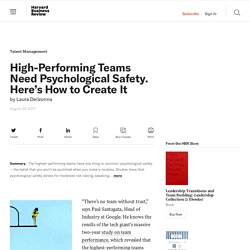
Studies show that psychological safety allows for moderate risk-taking, speaking your mind, creativity, and sticking your neck out without fear of having it cut off — just the types of behavior that lead to market breakthroughs. So how can you increase psychological safety on your own team? Was macht einen „Agile Leader” aus? - Scrum Akademie. Modern Agile. Three Common Misunderstandings Of Self-Organized Teams. Self-Organizing Teams: What and How - Scrum Alliance. Do you have a self-organizing team?
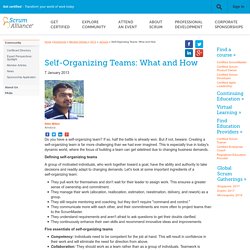
If so, half the battle is already won. But if not, beware: Creating a self-organizing team is far more challenging than we had ever imagined. This is especially true in today's dynamic world, where the focus of building a team can get sidelined due to changing business demands. Defining self-organizing teams A group of motivated individuals, who work together toward a goal, have the ability and authority to take decisions and readily adapt to changing demands.
They pull work for themselves and don't wait for their leader to assign work. Five essentials of self-organizing teams Competency: Individuals need to be competent for the job at hand. Creating a self-organizing team Who takes responsibility for making a self-organizing team? Spotify Engineering Culture Full Video (Agile Enterprise Transition with Scrum and Kanban)
No CEO: The Swedish company where nobody is in charge. Do you really need someone to tell you what to do at work?
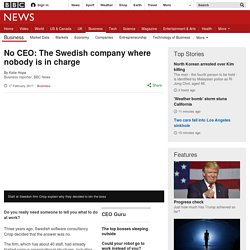
Three years ago, Swedish software consultancy Crisp decided that the answer was no. The firm, which has about 40 staff, had already trialled various organisational structures, including the more common practice of having a single leader running the company. Crisp then tried changing its chief executive annually, based on a staff vote, but eventually decided collectively that no boss was needed. Why isn't Holacracy working at Zappos? — Quartz. Las Vegas, Nevada “We want to believe that we are thinking, rational people and on occasion tangle with emotion, flick it out of the way, and go back to thinking,” renowned vulnerability expert Brene Brown told a packed house at the Smith Center in downtown Las Vegas just before Labor Day Weekend.
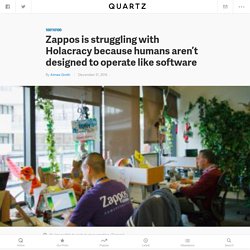
“That is not the truth. Creative entropy — a killer problem with Laloux’s evolutionary purpose. Get ready for 5 huge changes in the future of work. The workplace is changing.
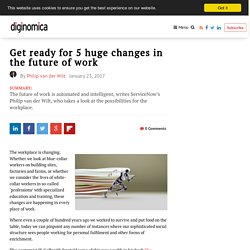
Whether we look at blue-collar workers on building sites, factories and farms, or whether we consider the lives of white-collar workers in so-called ‘professions’ with specialized education and training, these changes are happening in every place of work. Die HR-Abteilung heute: Vom Partner zum Vordenker. OpenWork sparks fresh thinking through sharing the stories of organizations reinventing how work gets done. By W.M.
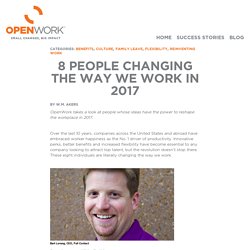
Akers OpenWork takes a look at people whose ideas have the power to reshape the workplace in 2017. Over the last 10 years, companies across the United States and abroad have embraced worker happiness as the No. 1 driver of productivity. By 2030, will we all be our own boss? Will the day come when we all work as our own boss?

Stephane Kasriel, CEO of Upwork and co-chair of the Global Future Council on Education, Gender and Work, says entrepreneurs and freelancers represent the future of the workplace, as traditional office jobs become less and less relevant. He explains what we need to do to prepare, how companies should react, and why there is still a glass ceiling to be shattered. Your Global Future Council has a very broad spectrum to cover. Daimler: Mit der „Schwarm-Organisation“ auf den Premium-Thron. Creative entropy — a killer problem with Laloux’s evolutionary purpose. The concept of ‘Evolutionary purpose’ — a central theme from Laloux’s Reinventing Organisations — is a deeply flawed conceptual model.

There’s convincing evidence that it doesn’t even exist, and even if you try to implement it anyway there are major flaws including ‘creative entropy’ — a gradual loosening of an organisation’s focus — which may be the opposite of what’s needed to realise a big idea. What is evolutionary purpose? Here’s what it means, from the Reinventing Organisations wiki: “…organizations are viewed as an independent energy field with a purpose that transcends its stakeholders. Agility foundation for change. The Biggest Workplace Trends To Watch For This Year. Did you know that 2016 is the year the first college graduates of Generation Z (born between 1994–2010) will enter the workforce?

Crazy, right? Think about the perspective they're going to bring to the workplace -- especially having grown up in an ever-connected, technology-focused world. Along with Generation Z, there are other workplace trends that will have a significant impact on office life this year. Boomerang employees, which are the folks who leave a company and return at a later stage, will become more acceptable. Workspaces will become more collaborative. Forbes Welcome.
Designing the digital workplace: Connectivity, communication, collaboration. By Ramez Shehadi, Christopher A.H.
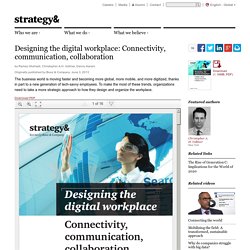
Vollmer, Danny Karam Originally published by Booz & Company: June 3, 2013 The business world is moving faster and becoming more global, more mobile, and more digitized, thanks in part to a new generation of tech-savvy employees. Forbes Welcome. The New Organization: Different by Design. We just launched one of the world’s largest studies of people challenges in business, Deloitte Human Capital Trends 2016, and the results were striking. Among the 7,000+ companies who responded (in over 130 countries), the #1 issue on leaders minds is “how to redesign our organizational structure” to meet the demands of the workforce and business climate today. Our conclusion, after almost a year of study, is that today’s digital world of work has shaken the foundation of organizational structure, shifting from the traditional functional hierarchy to one we call a “network of teams.”
This new model of work is forcing us to change job roles and job descriptions; rethink careers and internal mobility; emphasize skills and learning as keys to performance; redesign how we set goals and reward people; and change the role of leaders. Fig 1: The New Organization: A Network of Teams Fig 2: Relative Importance of the Ten Global Human Capital Trends. Forbes Welcome.